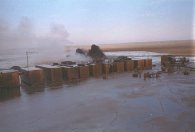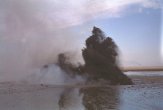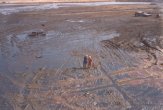 |
|||
| Location before broach | Immediately after broach | 48 hours after broach | Crater and oil/gas flow |
 |
 |
||
| Close-up of crater | Looking Southwest | Looking Northwest | Looking North |
On-site Assessment
Upon arrival at the blowout site an initial incident briefing was held on our behalf by the operators response team and technical support staff. During this meeting we were appraised of the current situation, their response organization, what had been done and what was being planned. At the end of this meeting we moved into the Initial Planning Cycle phase. The first Incident Action Plan (IAP) was to perform a Site Survey. The local response team had identified an exclusion zone around the blowout and had begun building berms around the location to collect the flowing oil and minimize pollution. They had purposely not made an onsite survey for safety reasons until the arrival of specialists.
After an assessment was made from the exclusion zone, and a safety and rescue plan devised, a site survey team was chosen. The team included John Wright, three blowout firefighters, the rig toolpusher and the operator's drilling superintendent.
The observations of the site survey team indicated the crater (located +/-125 m NW of the wellhead) was 10 to 15 m in diameter with crude oil being blown 30 to 50 m in the air by expanding gas. An area of approximately 100 m south and east and 150 m north and west of the wellhead was saturated with oil blown as a fine mist from the crater by prevailing north westerly winds. Gas was observed bubbling in many pockets of oil within the above perimeter, there was not any significant indication of gas in cellar area at this time. A hand held gas detector did not indicate explosive mixtures at waist level in any area except in close proximity to the crater. The wellhead pressure observed on the choke manifold was 340 psi. It was impossible to estimate the oil and gas flow by simple observations.